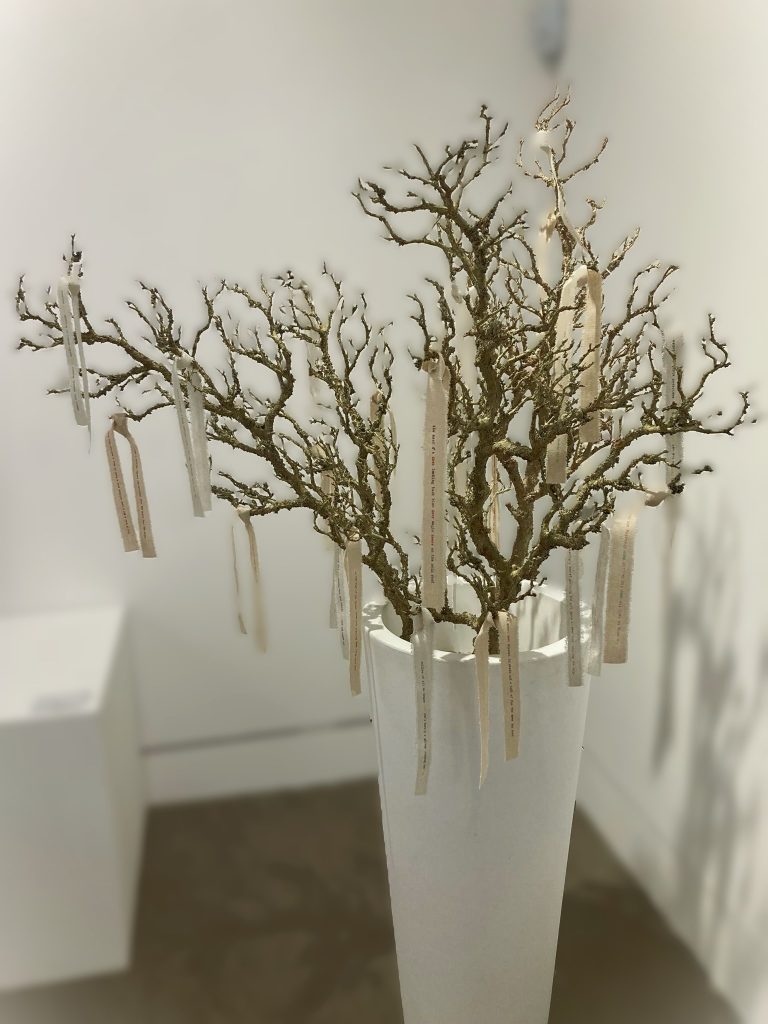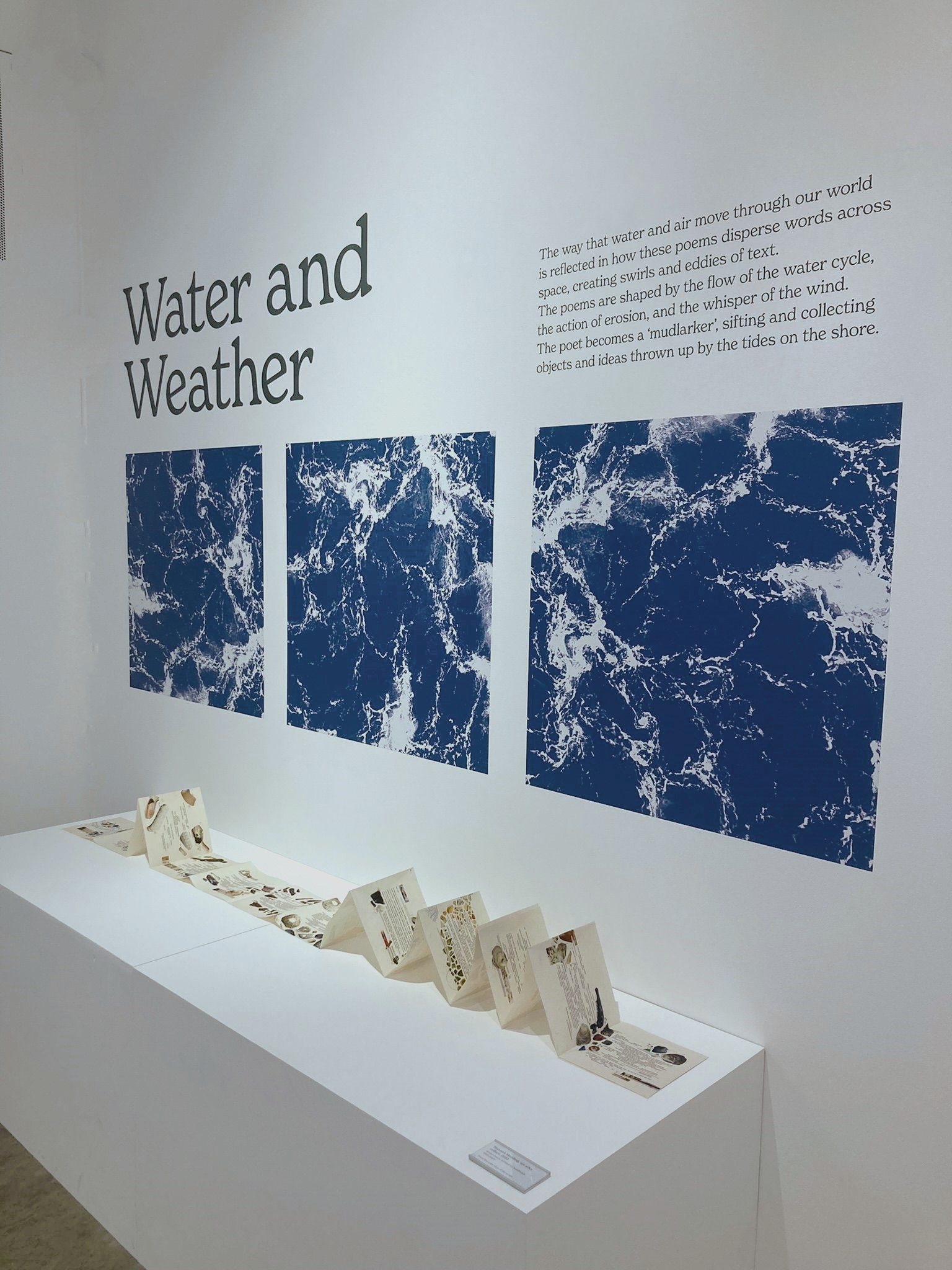Written by Anita Jergic
The library at Royal Holloway currently houses a wonderful exhibition displaying a collection of poetry concerning the environment and climate change. ‘Words from the Wild’ is an exciting exhibition that pushes the boundaries of what poetry is, incorporating visual and auditory elements to create a unique experience. I was lucky enough to interview one of the featured poets and curators, Briony Hughes. I learnt about the curation process, inspiration for writing, and the actual construction of some poems. I enjoyed listening to how mud larking and even bin lorries can inspire important poems raising awareness on climate change, and hope you do too.

Interview with Briony Hughes, co-curator of and poet writing for Words from the Wild
A: Tell me about the Title- what made you choose Words from the Wild?
B: Originally the title was more complex, we were looking at ‘Rewilding Rewording Reworlding’, followed by a subtitle on the topic of translation and material poetries. It read almost like an academic thesis. The exhibition is aimed not just at every student on campus but also the wider public. We wanted to invite people in, for visitors who are not specialists in poetry to feel like they can comfortably enter the space, for the exhibition to be accessible. Because the poetry in the exhibition disrupts what people traditionally see as poetry, we needed the title to be something that people felt familiar with, so they were guided into the space.
A: Tell me about the collaboration process
B: My co-curators were Caroline Harris and Gareth Hughes, who are both PhD candidates at Royal Holloway, alongside the Royal Holloway Culture team. I’ve worked collaboratively with Caroline in the past. We very much enjoy working together to curate a space and love the resonances and intimacies that emerge when our poetry is placed side-by-side. I also run a small press called Osmosis Press and published one of Caroline’s pamphlets titled A Summoning Spell for Lost Deer last year. Gareth Hughes is a specialist in French poetry and translation - he brought a lot of new insight and energy to the project. As I was a displayed artist, it was quite [nice] to put my curator hat on when working on my own creative projects, so to have Gareth there as an objective voice was really helpful. Naomi Lewbens, Peggy Ainsworth, and Anya Eastman from the Royal Holloway Culture team were fantastic. They had the knowledge of how to put on a large-scale public-facing exhibition, and the level of care, expertise, and creativity they brought to the team was second to none.
A: Can you tell me a little bit about the poem-to-exhibition transition? How did you distance yourself from your work to be able to exhibit and curate it?
B: The main piece that took a lot of energy in terms of curation was my sequence titled Weather Dialogue. The work was originally designed as a performance object, so editions of it are printed as a much smaller scroll compared to what is featured in the exhibition. You can find copies in the National Poetry Library and British Library. This is the largest scale I’ve exhibited it. I have very little control over how the poem will look when it unfurls – the page naturally turns and bends as it is unravelled, each time forming and reforming a new poetic structure. In the exhibition itself, Weather Dialogue was installed by Naomi Lebens whilst I directed her. The text is suspended on a structure of wires hanging from the walls, and the twists and loops of the page are very much guided by Naomi’s hand and the movement of the object itself. So, the version that is situated in the exhibition feels like a collaboration between myself as the writer and the people who I was working with to secure it. They determined the shape of the poem, and I guided [them].
A: That was actually my favourite piece, I felt it to be the most interactive because you had to look up and twist your neck to read the words and move a bit, so I feel that you’re going to have a different perspective every time you visit. But it would be exciting to see you perform the piece yourself.
Briony mentions there is an online performance, available at: SPAM ZINE: Briony Hughes reads from Weather Dialogue
A: I’d love to talk about the construction of the poems- you had some unique materials like tree bark, beeswax, and more ordinary objects like paper. Words from the Wild focuses on saving and protecting the environment, so how did you make sure the items you used and how you constructed the pieces were eco-friendly?
B: A major focus of the exhibition was on material eco-poetries, so quite a few of the practitioners we featured shift[ed] entirely away from the page, often toward found materials. Astra Papachristodoulou exchanges the paper page for a section of tree bark foraged from Bushy Park, whilst Kate Siklosi works with fallen leaves, seeds, and other woodland debris. Hannah Harding’s ‘we who collect’ was written in response to items that she had ‘mudlarked’ from the Thames Foreshore, meaning that the process of writing her poem involved removing objects from the riverbed. My Mudlarks project comprises six handmade sheets of paper, made from recycled materials and collected Thames water, whilst Susie Campbell’s Enclosures is printed entirely on recycled paper stock. Other projects held in the space are produced in small editions or printed on demand, reducing excess waste. Bee Swarm, featured at the start of the exhibition, is a sculpture made from bio-resin, a plant-based alternative to polyester resin. The plinths and movable walls of the exhibition space itself are re-used with each new event. The latest edition – the large, white pot currently holding Caroline Harris’ Clootie Ribbons, had a previous life displaying plants at a garden centre.
A: Many people have labelled the exhibition in different ways (performance art, visual art, etc), how do you respond to this? Can you defend your work as poetry?
B: I don’t feel the need to defend my work as poetry, I am happy for it to be read as whatever form of creative practice resonates with the viewers. I would say that the curated pieces sit on the boundary between poetry and other forms of creative practice, such as fine art, dance and performance, printmaking, and sculpture. One of the aims of the project is to call into question what poetry can be. Camilla Nelson’s worm tracings contain no words – language is reimagined as the movement of the worm’s bodies. Some pieces aren’t deemed as poetry by the artist Liz K Miller’s Forest Listening, for instance, is part of her fine art practice. She doesn’t call herself a poet but I read her work as poetry. She records [the] sound of water within the trees at close proximity; she’s voicing the trees and demanding a listening practice, which I think is more resonant with poetry. She’s really excited by the framing of her work as poetry, because when something is designated as a poem we’re asking people to read the work with all the traditions and innovations of poetry in mind, so her work is framed against a new set of historical contexts.
A: Which poets inspired you?
B: I am excited by writers such as Julianna Spahr, Kathleen Fraser, Jay Bernard, Maggie O’Sullivan, Anne Carson, and Susan Howe. I’d say those four writers are really influential in my writing practice. I also quite love book artist Joanna Drucker - the Royal Holloway Library has curated a selection of books that sit in conversation with the exhibition, and one of Drucker’s rare books is on display, which is quite nice to see.
A: Were there any poets or poetic practices you were working against?
B: We’re moving away from romantic presentations of the natural world as sublime, beautiful, or to be elevated by human presence. Quite a lot of the pieces in our exhibition pay close attention to things that are horrendous or uncomfortable such as pollution, deforestation, and insect decline. There’s nothing beautiful about that. Personally, I am very interested in the problem of water; my creative practice looks at water as this grandiose mass that connects ecosystems and communities and enables life but is also something that can be incredibly destructive. I’m thinking in terms of weather catastrophes but also colonialism, global inequalities of water and pollution. I think poetry allows you to take a nuanced approach to something. I’m not interested in writing a nice poem about the sea, I’m much more interested in the piece of plastic that is floating on the shoreline.
A: Could you say you’re taking nature more seriously, rather than romanticising and infantilising it for your own pleasure?
B: Yeah absolutely!
A: As a fellow writer, I would love to know more about what inspired you. Is there a way we can access a methodology of some sort?
B: As a writer, I am always asking myself ‘What role can poetry play in a climate-altered future?’ Often, I arrive at the idea of speculation. Climate catastrophe is such a vast and overwhelming topic – we need people from all disciplines, communities, and backgrounds to collaborate, think outside the box, speculate, and find equitable solutions. When I put pen to paper, I am working to anticipate a future, document a fragment of our present moment, or speculate on the role language plays in the world. In the exhibition space, there’s a post box offering the following question: ‘How might our woodlands, oceans, and cities change by 2075? Fill this page with speculative sounds and textures’, so there’s an opportunity within the space for people to respond creatively and be a part of the textual make-up of the exhibition.
A: Do you have any advice for young poets, and for poets writing in the environmentalist field?
B: Read, read, and keep reading! There are lots of really exciting online publications that are free to access – you can find these listed on poetsdirectory.co.uk. Remember that your work is in dialogue with all other poets – you are part of a vast and expansive community. Lean into that. Our exhibition, for example, wouldn’t have occurred if I didn’t have community with Caroline. It’s also nice to read. My answer is ‘eat up as much poetry as you can’.
The exhibition entitled Words from the Wild is curated by Briony Hughes, Caroline Harris, and Gareth Hughes. It features work from Briony Hughes, Caroline Harris, J.R Carpenter, Susan Johanknecht, Katherine Meynell, Camilla Nelson, Redell Olsen, and others. It is on display in the library until the 24th of March in the Emily Wilding Davison Building at Royal Holloway University of London.
Written by Anita Jergic, Edited by Paige Tamasi, Photography by Anita Jergic, Published by Paige Tamasi.
